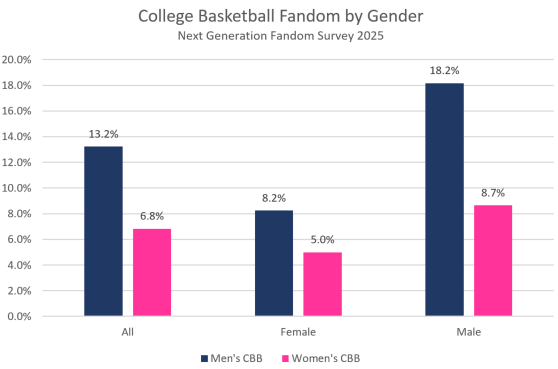Offseason Analysis: Men's and Women's College Basketball Fandom
Surprising Results for Gen Z and Female Fandom
It's off-season for college basketball, but I’m currently building a class session focused on college basketball fandom and the NCAA “March Madness” tournament(s). At Emory (and most top schools), we have a lot of International students these days, so the plan is to do some sessions focusing on key events in the sports and cultural calendar. The goal of the session will be to discuss the cultural relevance of college basketball and March Madness. As part of this deck, I pulled data on fandom and apathy for the Men’s and Women’s college games by gender and generation.
Fandom
The first figure shows fandom for the entire 1610-person sample and for the male (N=809) and female (N=801) subpopulations. The Men’s game has almost twice the fandom of the Women’s game. This is an interesting result. In some ways it seems like too big of a gap as the women’s game has grown in prominence over the last few years. However, it also seems like too small of a gap because the men’s game generates much more revenue and attendance.
The mismatch between metrics like social media coverage, attendance, and revenues is what makes college basketball such a fascinating context. The survey data just adds to the story. Of course, its always important to note that survey data measures self-reported attitudes rather than behavior. The essential point is that it’s easier to claim to be a fan than to spend and attend.
At the gender segment levels, males report greater fandom for both the Men’s and Women’s games. This is also an interesting result as it suggests that fandom is driven more by specific sports and general sports interest than by gender identity. There is logic behind this result. If men are more likely to be sports fans, then the male subgroup will be more exposed to the women’s games through traditional sports media. This is speculative, as it could also be argued that females use social media more and might consequently be more likely to encounter coverage of the Women’s game on social channels.
The gender segment results are another great data point, but survey data is always limited, as people’s answers are affected by social realities in unknown ways. This is one of the fundamental challenges in assessing fandom-oriented categories. Fandom is constantly shifting attitude, which is impacted by social currents.
Apathy
The second figure shows the apathy rates for Men’s and Women’s College Basketball. Apathy is important because it represents the percentage of the population(s) who just do not care—the unconvertible. Growing a game requires attracting the “neutrals,” usually by making the cultural product a social unifier.
For the overall population, the apathy rate for the Men’s game is 39.7% and 51.9% for the Women’s. The apathy rates may seem high as they are three and seven times the fandom rates for the Men’s and Women’s games, respectively. An essential issue is that in 2025, the sports and cultural marketplaces are fragmented, and most people aren’t interested in most sports. This year, 18.5 million viewers watched the Men’s title game and 8.5 million the Women’s title game. These are decent audiences, but they imply that less than 6% of Americans watched the Men’s championship game and only about 2.5% the Women’s.
The gender segments are again revealing. The male apathy rates are 29% for the Men and 44.9% for the Women. The female rates are substantially higher at 50.4% for the Men and almost 60% for the Women. Again, the apathy rates are the products of history and cultural norms, but the high female apathy rate should be noted when considering fandom growth.
Generations
The third figure shows the fandom rates across the four major sports consuming generations: Gen Z, Millennials, Gen X, and Baby Boomers. Men’s and Women’s College Basketball have similar generational patterns, as both peak with Millennials and bottom out with Gen Z. The ratio of Men’s to Women’s fandom peaks at 2.1 times for the Baby Boomers and is lowest at 1.7 times for Millennials.
It's not shown in the figure, but a further segmentation within Gen Z that splits the population into 20 and under versus 21 and above provides a critical result. For the male group, the “Young” Gen Z males report a 6.3% fandom rate for Men’s College Basketball compared to 16.4% for the “Old” Gen Z segment. For Women’s College Basketball, the “Young” fandom rate is 2.9% versus 7.9% for the “Old” Gen Z’s. This suggests that college basketball is no longer a mainstream sport, as it appears that people need to reach college age before they have a significant interest.
Final Thoughts
I have no grand conclusions today. I think collegiate and pro women’s basketball is currently the most fascinating arena for studying fandom. It's intriguing because so much is happening. Ratings are spiking, but revenues are low. Media deals are being redone, and sponsors are flocking to the game. On the other hand, much of the heightened interest seems to be centered on a single player. Is the bump in interest a celebrity-driven fad or a real trend? With so much happening, it's impossible to draw solid conclusions.
I’ve got opinions and data, but no answers. At this moment, I think it's more fun to leave this as a debate.






